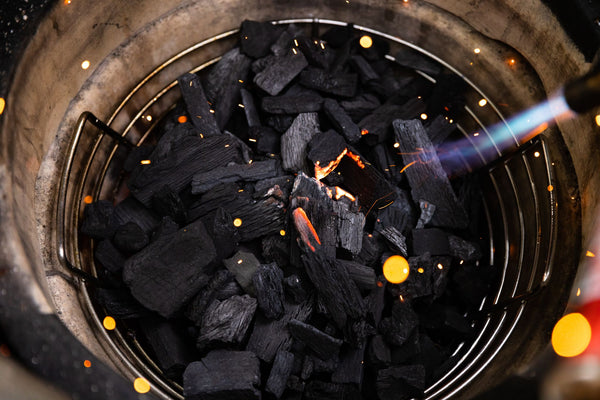
Best Time for Grilling Salmon
A perfectly grilled salmon has a hearty seafood taste that still pairs well with any number of sauces and light crusts or dressings. It’s also notoriously fickle to cook. You’ll need to heat it up enough to melt down the tougher parts, but not enough to turn it to a chalky powder.
In this post, we’re going to look at the wonderful art of grilling salmon. You’ll get advice on how long to cook it, what salmon cuts to grill, what you should pair it with, and expert tips for grilling salmon that will take your plate to the next level.
Alright! Grab a kick ash basket and ash can from our shop by grill section, and let’s fire up some hearty seafood.


Prepping Salmon for the Grill
Fresh salmon doesn’t need very many accompanying flavors to get a delicious meal. While some greens off to the side will make a lovely, lemony pair, the salmon itself should have minimal seasoning. You don’t want to ruin it with strong flavors!
A thick salt and pepper crust on the flesh side will help build resistance to the heat while improving the textures at the edges. It’s best to use coarse-grained salt and pepper, which you can grind fresh, directly on the salmon. If you’re pulling the filet out of the fridge, you should salt and pepper immediately and then let rest for about thirty minutes before you grill. If you’ve just gotten the salmon home and it has had some time to unthaw, you can skip the waiting time. The best way to salt and pepper the fish will be to grind coarse salt and pepper onto a plate or dish, and then rub the salmon in them, flesh side down. This allows the weight of the salmon to gently pick up the salt and pepper, and it won’t just sit on top before falling off.
If salt and pepper don’t seem strong enough for your taste, a parmesan-crusted salmon might be just perfect! Alternatively, we sell some bold BBQ rubs that will change the way that your salmon pairs with food. If you’re looking for something a bit more savory and heavy, a BBQ rub can give your salmon a new flair.
Salmon can also be great with a strong marinate. Ginger and soy are popular flavors to marinate your salmon in, which gives you a stronger, tangier salmon flavor. Keep in mind that salmon will soak up flavors pretty quickly (it’s a fish after all!), so you won’t want to marinate for over 24 hours. If the marinate has acid in it, keep it to thirty minutes to prevent your fish from turning to smelly mush.
Cooking the Perfect Salmon
Grilling Salmon SteaksA salmon steak is a cross-cut piece of salmon that may still have the spine and smaller pin bones in the middle. If you’ve gotten your steaks deboned, then you’re good to go; otherwise, you’ll have to use a knife to remove the bones. You can get the bones out of a salmon steak by putting your knife between the ribs and the flesh on the belly and following the ridge to the other side.
Once deboned, you can marinate or crust-like normal and toss on the grill. The grill should be just under 400 degrees and the salmon will take about 9-12 minutes. The actual cooking time will depend on the type of charcoal grill you’re using and the heat level.
Grilling Salmon FilletsPerfectly cooked salmon will hit an internal temperature of about 130 degrees. Pull it off, and it will fall apart. It won’t be cooked so long that it becomes stringy and tough, but it will be cooked long enough to hold its texture. If your salmon is about an inch thick, then it will take about 9-12 minutes on a 400-degree grill to hit that perfect 130. Evenly cooked salmon tastes great all the way down and ensures that the texture is sound.
Salmon filets that still have the skin on do not need to be flipped when you’re grilling. Put the skin side down on the grill, and the heat will transfer throughout the fish just fine. The skin creates an extra barrier from the heat which allows the open top to cook just as quickly, even though it is further from the heat and pointed in the opposite direction.
However, many people will still choose to flip because you can get a quick char on the flesh side. As salmon heats up, it will begin to fall apart. Flipping to place the non-skin side down can cause the fish to fall apart, losing the most tender pieces down into the grill. When you flip, don’t be aggressive with the fish like you’re flipping a hamburger. A gentle toss will go a long way, and make sure the fish doesn’t slide when it hits the hot grill.
Grilling Salmon Without SkinThe skin on salmon provides a nice flashpoint for grilling when you first toss it on the heat. It holds the fish together and protects it against the harsher flames for the lengthy portion of grilling. It’s also perfectly safe to eat, and has plenty of nutrients inside. However, you might have salmon without skin as well. If you do, you’ll need to work to keep the salmon together while grilling so that it doesn’t lose its shape or fall apart.
The key here is to not move or nudge the salmon except when flipping. When you place the salmon on the grill, don’t move it a lot, let it rest. When you go to flip, use tongs to carefully and gently flip it over. Salmon is delicate—but not incredibly delicate so that it falls apart like a sandcastle! It’s just best to keep movement to a minimum if possible.
Can I Grill Salmon in Aluminum Foil?Foil is useful when you have juices that you really want to remain next to the meat. Salmon isn’t going to shed a lot of juice, so it won’t benefit from the foil in the same way. Plus, you close things off from the tasty smoke floating around in the grill—and smoke is a great additional flavor booster for salmon. You technically can grill it in foil, especially if you’re cooking in a bit of lemon or liquid, but it isn’t necessary for more purest forms of salmon grilling.
If you want to really make your perfect grilled salmon interesting, try grilling lemon halves with salmon. You might not even need the foil though!


Photo by Casey Lee on Unsplash
Salmon Grilling Tips
While you’re grilling salmon, you might notice some white gunk oozing out of the fish. Don’t worry, this is pretty standard for salmon. The white gunk is just coagulated protein that is heating up, turning to liquid, and coming off. It’s totally harmless to eat but you can also wipe it off when you’re done grilling.
130 is a general target for internal temperatures, but you can also check to see if your salmon is done by peeking at the thickest part. Salmon will change from a red translucent color to a pink opaque color as it cooks. The middle shouldn’t be totally pink, but should still have a bit of shine to it. Once you hit that point, pull it from the grill.
Salmon pairs wonderfully with different kinds of white wines, vegetables, and sauces. Let’s get cooking!


